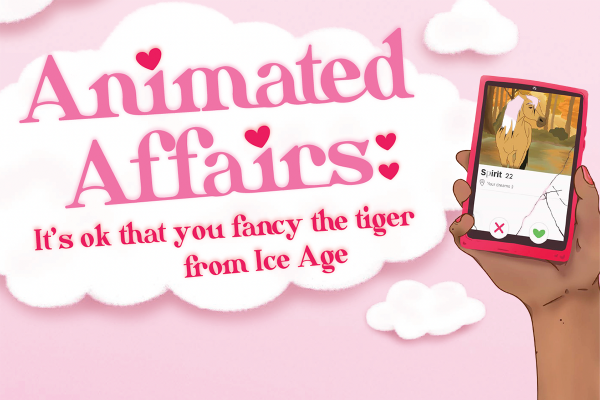Let’s talk about the legendary sexual awakening. There are the classics you always hear of: Katy Perry’s ‘I Kissed a Girl’ music video or Joe Jonas emerging, glistening, from the water in Camp Rock. A good number of people recall the moment Miss Honey from Matilda pulls down her glasses as the birth of their libido. Freud would have a field day.
Regrettably, my earliest memory of burning lust was ignited by none other than the lead character of DreamWorks’ 2002 Spirit: Stallion of the Cimarron. Yes, you read that correctly. Spirit, the cartoon horse voiced by Matt Damon. Perhaps it was his chiselled physique, unflinching bravery, or the Bryan Adams ballad blaring as he galloped across the American plains. Either way, my chubby little fingers found the VHS’s rewind button. Over and over again.
Only recently, when I was invited to a ‘dress as a fictional character you find attractive’ party, I realised this wasn’t an uncommon experience. Friends and classmates reminisced over Aladdin’s broad shoulders and the curve of Jessica Rabbit’s hips. Drink in hand, I found my mind drifting from Robin Hood’s (the 1973 fox version of course) masculine agility to the very question of why this seemed to be a universal encounter. Naturally, I needed answers. I took one for the team and risked adding that to my search history. You’re welcome.
It didn’t take me long to find ‘toonophilia’, a sexual identity that involves physical attraction to cartoon characters. The internet is rife with stories of twenty-somethings who believe they are in committed relationships with anime characters. Imagination working overtime, they share deep conversations, dinner dates, and vacations with their cartoon companions. Somewhat understandable, as it’s no secret that anime has been sexualising characters to appeal to audiences for decades. Still, this felt different to my innocent childhood crush on Mustang Matt Damon.
I approached Research Psychologist and Sexologist Professor Jesse Bering for some consolation. Luckily, there's a key distinction between being a ‘toonophile’ and thinking Gill from Finding Nemo is a complete daddy, as Professor Bering explained. “Those are two completely different things. A true diagnostic disorder [of toonophilia] would mean that you only get aroused by this particular erotic stimulus.” That is, unless you ONLY get turned on by a sexy Pixar fish, you’re not a toonophile. Thankfully, Spirit and I were never exclusive.
If you’ve ever questioned the reasoning behind Disney making all these cartoon animals so damn sexy, you’re not the only one. As Professor Bering pointed out, “These characters are highly anthropomorphised, there’s a tinge of sexuality oftentimes laden on them.” Attraction plays a huge role in how children's characters are received by audiences, and with children's television raking in billions of dollars annually, designers use our innate desires to their advantage. We love attractive characters, and the industry knows it. The result is idealised half-humans with exaggerated features– symmetrical faces, large eyes, tiny noses, and shiny, flowing hair. All the features society typically associates with beauty. Even their personalities typically embody socially desired traits. In Western cultures, this is most commonly self-expression, individualism, and freedom. This way we connect with them on an emotional level, and they become more engaging and memorable. Robin Hood was daring yet compassionate; Spirit was a devoted and protective leader of his herd, and Jessica Rabbit was uhhh… manipulative. Even the way they move is designed to captivate you, every gesture and expression is made with supernatural grace. They knew exactly what they were doing when they made Nala slink around and collapse into the grass to the tune of ‘Can You Feel the Love Tonight’.
Professor Bering explained that this sexualisation is hard to ignore. “It’s normal and natural for people to notice that, especially children who are curious.” In short, it’s not your fault – your pre-pubescent self was bound to find them a little sexy, and that’s okay. Even nostalgia may explain your lasting attraction. Precious childhood memories can bring a sense of comfort, safety, and stability. Maybe deep down, I just want Spirit to do my taxes and run me a bubble bath (not sure how this works with hooves but I’m optimistic).
Above all, it’s important to think of attraction as a complex and free-flowing concept: one that sometimes holds sense, and sometimes does not. Any number of qualities and factors may influence your attraction to someone or something, from your physical senses to your immune system. There is a whole world of theories out there, some that I’d rather go without seeing. However, having random crushes during those formative years appears to be a normal part of developing a sense of self. As Professor Bering pointed out, “If we all ask ourselves honestly what has turned us on over the course of our lives, there are lots of little things that we may be uncomfortable with, and that’s probably quite normal.” The point is — as long as it’s not negatively impacting your health and well-being — don’t take it too seriously. Do my nonsensical childhood fantasies mean that adult me wants to fuck a horse? Professor Bering reassured me, “That is definitely not the case” (phew).
On that note, you might wonder if this is all just an elaborate attempt to justify my own equine eroticism. Could be. But if you, too, felt something when Li Shang from Mulan said he’d “make a man out of you,” just know that you aren't alone. It seems the cartoon crush is natural. A rite of passage, if you will.



